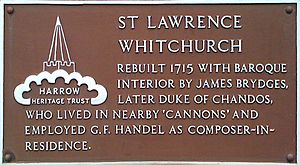Little Stanmore facts for kids
Quick facts for kids Little Stanmore |
|
|---|---|
| OS grid reference | TQ189912 |
| London borough | |
| Ceremonial county | Greater London |
| Region | |
| Country | England |
| Sovereign state | United Kingdom |
| Post town | EDGWARE |
| Postcode district | HA8 |
| Dialling code | 020 |
| Police | Metropolitan |
| Fire | London |
| Ambulance | London |
| EU Parliament | London |
| UK Parliament |
|
| London Assembly |
|
Little Stanmore was once an old parish in Middlesex, England. Today, it's a part of the Canons Park area within the London Borough of Harrow. This historic parish also covered the western side of the town of Edgware.
What's in a Name? The Meaning of Stanmore
The name 'Stanmore' has a cool meaning: "pond made of stone." Imagine a pond with stone edges!
Little Stanmore got its name to tell it apart from Great Stanmore, which is now just called Stanmore. The area was also known as Whitchurch. This name means 'white church', probably because there was a church built from stone there. You can still find this old name in places like Whitchurch Gardens and Whitchurch Lane.
A Glimpse into Little Stanmore's Past
Little Stanmore was an old parish in the Gore area of Middlesex. It included the western part of Edgware.
Over time, the way the area was managed changed. In 1836, it joined with other places to help people in need. Later, in 1894, it became part of the Hendon Rural District. Little Stanmore stopped being a separate civil parish in 1934. It then became part of the Harrow Urban District.
The number of people living in Little Stanmore grew a lot! In 1901, about 1,069 people lived there. By 1931, the population had jumped to 6,918.
St Lawrence's Church: A Historic Building
The old St Lawrence's Church was rebuilt in a fancy style called baroque. This happened thanks to James Brydges, 1st Duke of Chandos. The architect, John James, also worked on the Duke's nearby house, Cannons.
The church's inside still has beautiful paintings from the early 1700s by artists like Louis Laguerre. It also has a special organ that was played by the famous composer Handel. This organ was carefully fixed in the 1990s to be just like it was originally.
In the churchyard, you can find a tombstone for William Powell. People say he was "The Harmonious Blacksmith" who inspired one of Handel's famous music pieces. The church is also the final resting place of the singer Long John Baldry.



